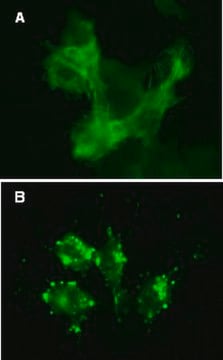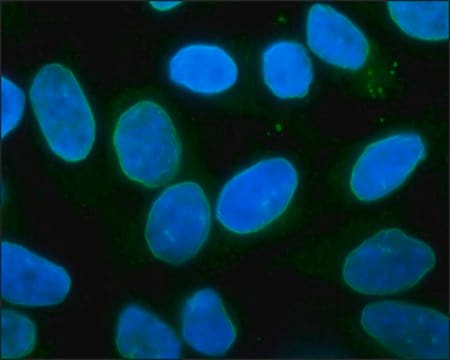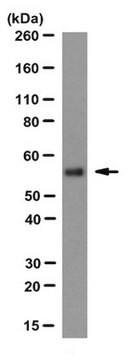06-1002
Anti-LAP2 Antibody
from rabbit, purified by affinity chromatography
Synonyme(s) :
LEM domain containing 4, TP alpha, TP beta/gamma, TPRP isoform alpha, TPRP isoforms beta/gamma, Thymopoietin isoform alpha, Thymopoietin, isoforms beta/gamma, Thymopoietin-related peptide isoform alpha, Thymopoietin-related peptide isoforms beta/gamma, l
About This Item
Produits recommandés
Source biologique
rabbit
Niveau de qualité
Forme d'anticorps
affinity isolated antibody
Type de produit anticorps
primary antibodies
Clone
polyclonal
Produit purifié par
affinity chromatography
Espèces réactives
rat, human, mouse, canine
Technique(s)
immunocytochemistry: suitable
immunofluorescence: suitable
western blot: suitable
Numéro d'accès NCBI
Numéro d'accès UniProt
Conditions d'expédition
wet ice
Modification post-traductionnelle de la cible
unmodified
Informations sur le gène
human ... TMPO(7112)
Description générale
The best characterized isoforms of lamin binding protein LAP2 are LAP2α and LAP2β. LAP2β is a type II membrane protein in the inner nuclear membrane that binds lamin B and is important to cell viability and controlling nuclear lamina growth. LAP2α has been characterized as a nucleoplasmic protein that interacts with A-type lamins to control gene expression, transcription, and chromatin organization.
Spécificité
Immunogène
Application
Representative lot data. This antibody was used to detect the nuclear lamina by immunofluorescence.
Immunocytochemistry:
Representative lot data.
A previous lot was used in confocal fluorescent analysis of A431, HeLa and NIH/3T3 cells using anti-LAP2 rabbit polyclonal antibody (Red).
Actin filaments have been labeled with AlexaFluor 488 -Phalloidin (Green). Nuclear is stained with DAPI (Blue). Positive nuclear staining.
Epigenetics & Nuclear Function
Cytoskeletal Signaling
Qualité
Western Blot Analysis:
A 1:1000-1:3000 dilution of this antibody was used to detect LAP2 in HeLa cell lysate.
Description de la cible
Forme physique
Stockage et stabilité
Remarque sur l'analyse
HeLa cell lysate
Clause de non-responsabilité
Not finding the right product?
Try our Outil de sélection de produits.
Code de la classe de stockage
12 - Non Combustible Liquids
Classe de danger pour l'eau (WGK)
WGK 1
Point d'éclair (°F)
Not applicable
Point d'éclair (°C)
Not applicable
Certificats d'analyse (COA)
Recherchez un Certificats d'analyse (COA) en saisissant le numéro de lot du produit. Les numéros de lot figurent sur l'étiquette du produit après les mots "Lot" ou "Batch".
Déjà en possession de ce produit ?
Retrouvez la documentation relative aux produits que vous avez récemment achetés dans la Bibliothèque de documents.
Notre équipe de scientifiques dispose d'une expérience dans tous les secteurs de la recherche, notamment en sciences de la vie, science des matériaux, synthèse chimique, chromatographie, analyse et dans de nombreux autres domaines..
Contacter notre Service technique








